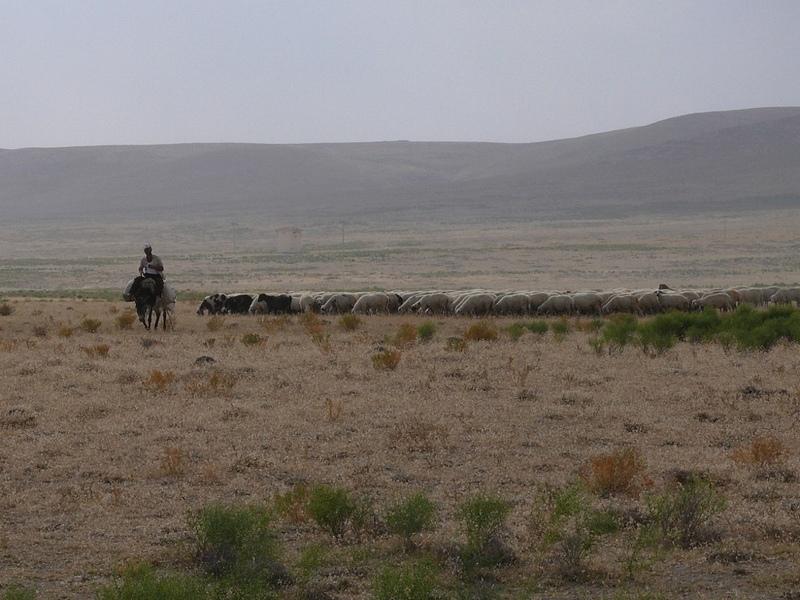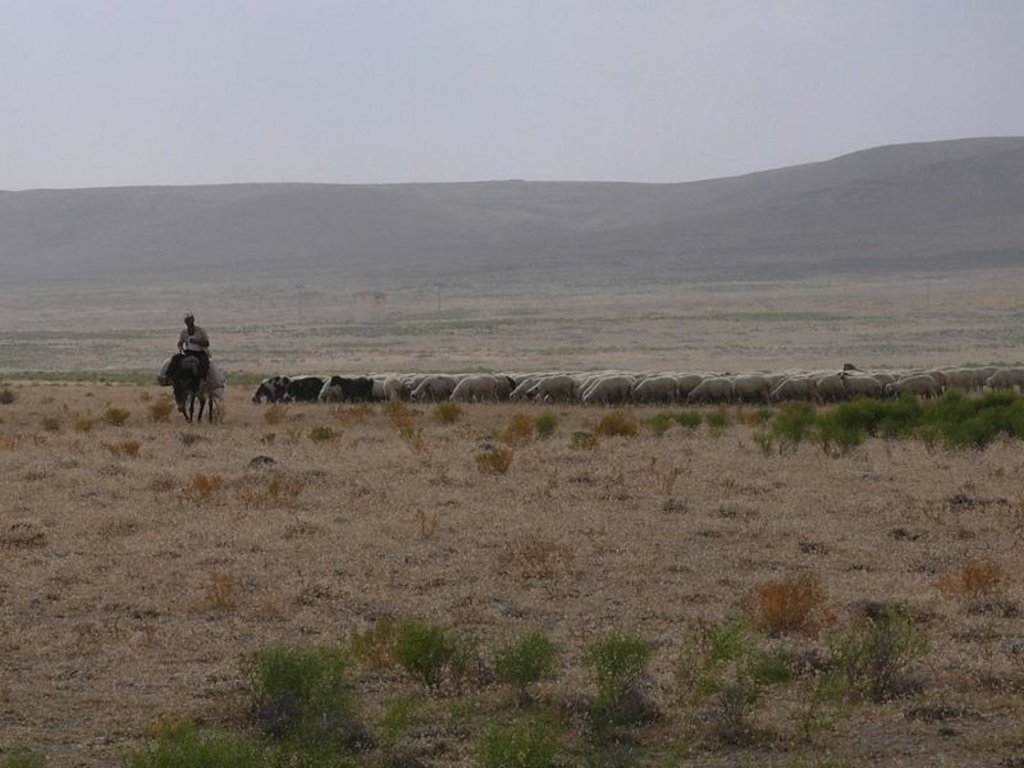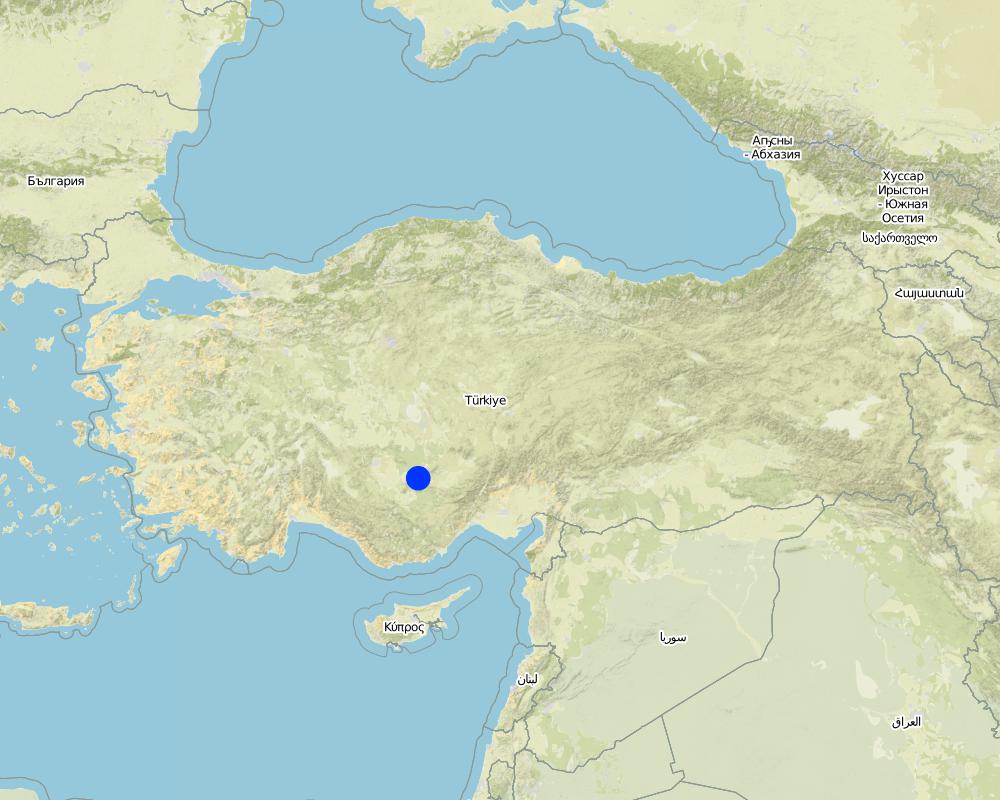Rotational Grazing [ตุรกี]
- ผู้สร้างสรรค์:
- การอัพเดท:
- ผู้รวบรวม: Mehmet Zengin
- ผู้เรียบเรียง: –
- ผู้ตรวจสอบ: Fabian Ottiger, Alexandra Gavilano
Kontrollü Otlatma (Turkish)
technologies_1398 - ตุรกี
ดูส่วนย่อย
ขยายทั้งหมด ย่อทั้งหมด1. ข้อมูลทั่วไป
1.2 รายละเอียดที่ติดต่อได้ของผู้รวบรวมและองค์กรที่เกี่ยวข้องในการประเมินและการจัดเตรียมทำเอกสารของเทคโนโลยี
1.3 เงื่อนไขการใช้ข้อมูลที่ได้บันทึกผ่านทาง WOCAT
ผู้รวบรวมและวิทยากรหลักยอมรับเงื่อนไขเกี่ยวกับการใช้ข้อมูลที่ถูกบันทึกผ่านทาง WOCAT:
ใช่
2. การอธิบายลักษณะของเทคโนโลยี SLM
2.1 การอธิบายแบบสั้น ๆ ของเทคโนโลยี
คำจำกัดความของเทคโนโลยี:
Allowing livestocks to graze in pasturelands in a periodic and regular manner.
2.2 การอธิบายแบบละเอียดของเทคโนโลยี
คำอธิบาย:
Sheep breeding has been very common for a long time in the Karapinar district. Sheep grazes in 50 km2 pasture area within the DESIRE hotspot during summers and they are fed in stables in winters. Pasture areas are degraded due to lack of rain, overgrazing and no-remediation. Farmers allow their livestock to go out from early spring onwards due to expensive feed costs in stables. A pasture can not feed sheep efficiently due to high numbers of sheep, early grazing and soil weakness due to high wind erosion. If a part of pasture is grazed one year, the remaining parts will be grazed coming year, in this way pastures are rested in rotation. So, in rested pastures soil erosion will be minimum since herb growth is good for the next year.
2.3 รูปภาพของเทคโนโลยี
2.5 ประเทศภูมิภาค หรือสถานที่ตั้งที่เทคโนโลยีได้นำไปใช้และได้รับการครอบคลุมโดยการประเมินนี้
ประเทศ:
ตุรกี
ภูมิภาค/รัฐ/จังหวัด:
Konya
ข้อมูลจำเพาะเพิ่มเติมของสถานที่ตั้ง :
Karapinar
แสดงความคิดเห็น:
Total area covered by the SLM Technology is 50 km2.
Map
×2.6 วันที่การดำเนินการ
ถ้าไม่รู้ปีที่แน่นอน ให้ระบุวันที่โดยประมาณ:
- 10-50 ปี
2.7 คำแนะนำของเทคโนโลยี
ให้ระบุว่าเทคโนโลยีถูกแนะนำเข้ามาอย่างไร:
- ทางโครงการหรือจากภายนอก
3. การจัดประเภทของเทคโนโลยี SLM
3.2 ประเภทของการใช้ที่ดินในปัจจุบันที่ได้นำเทคโนโลยีไปใช้

พื้นที่ปลูกพืช
- การปลูกพืชล้มลุกอายุปีเดียว
Annual cropping - Specify crops:
- cereals - barley
- cereals - wheat (spring)
- cereals - wheat (winter)
- fodder crops - clover
- root/tuber crops - sugar beet
- corn
จำนวนของฤดูเพาะปลูกต่อปี:
- 1
ระบุ:
Longest growing period in days: 240Longest growing period from month to month: Oct - MaySecond longest growing period in days: 180Second longest growing period from month to month: May - Oct

ทุ่งหญ้าเลี้ยงสัตว์
Extensive grazing:
- กึ่งโนแมนดิซึ่มหรือแพสโตแรลลิซึ่ม (Semi-nomadism/pastoralism)
Animal type:
- sheep
แสดงความคิดเห็น:
Major land use problems (compiler’s opinion): Annual precipitation is low (270 mm) while evaporation is high (750 mm) per year. Soils are thin because of wind deflation and degradation. As a result soil fertility is low and biomass is very poor. Negatively, farmers grow plants that need lots of water. Strip farming has not been performed and drip irrigation is not preferred method.
Major land use problems (land users’ perception): Irrigation water is scarce, pasture lands are very poor, electricity for irrigation is very expensive.
Semi-nomadism / pastoralism: sheep in natural pastures.
Livestock is grazing on crop residues
3.4 การใช้น้ำ
การใช้น้ำของที่ดินที่มีการใช้เทคโนโลยีอยู่:
- จากน้ำฝน
แสดงความคิดเห็น:
Water supply: rainfed
3.5 กลุ่ม SLM ที่ตรงกับเทคโนโลยีนี้
- การจัดการปศุสัตว์และทุ่งหญ้าเลี้ยงสัตว์
- การปรับปรุงดิน / พืชคลุมดิน
- Rotational grazing
3.6 มาตรการ SLM ที่ประกอบกันเป็นเทคโนโลยี

มาตรการอนุรักษ์ด้วยวิธีพืช

มาตรการอนุรักษ์ด้วยการจัดการ
แสดงความคิดเห็น:
Main measures: management measures
Secondary measures: vegetative measures
Type of vegetative measures: scattered / dispersed
3.7 รูปแบบหลักของการเสื่อมโทรมของที่ดินที่ได้รับการแก้ไขโดยเทคโนโลยี

การกัดกร่อนของดินโดยลม
- Et (Loss of topsoil): การสูญเสียดินชั้นบน

การเสื่อมโทรมของดินทางด้านชีวภาพ
- Bc (Reduction of vegetation cover): การลดลงของจำนวนพืชที่ปกคลุมดิน
- Bh (Loss of habitat): การสูญเสียแหล่งที่อยู่
- Bq (Quantity/biomass decline): การลดลงของปริมาณหรือมวลชีวภาพ
- Bs (Quality and species composition): องค์ประกอบหรือความหลากหลายทางคุณภาพและชนิดพันธุ์ลดลง
- Bl (Loss of soil life): การสูญเสียสิ่งมีชีวิตในดิน
แสดงความคิดเห็น:
Main type of degradation addressed: Et: loss of topsoil, Bc: reduction of vegetation cover, Bh: loss of habitats
Secondary types of degradation addressed: Bq: quantity / biomass decline, Bs: quality and species composition /diversity decline, Bl: loss of soil life
Main causes of degradation: overgrazing (Controlled grazing must be performed immediately.), droughts (Yearly temperature is increasing.), population pressure (Population increases parallel to the labourlessness.)
Secondary causes of degradation: disturbance of water cycle (infiltration / runoff) (Annual rain is low.), over abstraction / excessive withdrawal of water (for irrigation, industry, etc.) (Groundwater is excessively used to irrigate plants of high water demand.)
3.8 การป้องกัน การลดลง หรือการฟื้นฟูความเสื่อมโทรมของที่ดิน
แสดงความคิดเห็น:
Main goals: rehabilitation / reclamation of denuded land
Secondary goals: prevention of land degradation, mitigation / reduction of land degradation
4. ข้อมูลจำเพาะด้านเทคนิค กิจกรรมการนำไปปฏิบัติใช้ ปัจจัยนำเข้า และค่าใช้จ่าย
4.1 แบบแปลนทางเทคนิคของเทคโนโลยี
ข้อมูลจำเพาะด้านเทคนิค (แบบแปลนทางเทคนิคของเทคโนโลยี):
Main technical functions: improvement of ground cover, reduction in wind speed
Secondary technical functions: increase in organic matter, increase in nutrient availability (supply, recycling,…), increase of infiltration, increase / maintain water stored in soil, increase of groundwater level / recharge of groundwater, sediment retention / trapping, sediment harvesting, increase of biomass (quantity)
Scattered / dispersed
Vegetative material: C : perennial crops
Number of plants per (ha): 5000000
Perennial crops species: graminea and laguminosa
Layout change according to natural and human environment: densely herb growing
Major change in timing of activities: rotational grazing
4.2 ข้อมูลทั่วไปเกี่ยวกับการคำนวณปัจจัยนำเข้าและค่าใช้จ่าย
อื่นๆ หรือสกุลเงินประจำชาติ (ระบุ):
Turkish Liras
If relevant, indicate exchange rate from USD to local currency (e.g. 1 USD = 79.9 Brazilian Real): 1 USD =:
1.3
ระบุค่าเฉลี่ยของค่าจ้างในการจ้างแรงงานต่อวัน:
17.00
4.3 กิจกรรมเพื่อการจัดตั้ง
| กิจกรรม | Timing (season) | |
|---|---|---|
| 1. | sowing | early spring / once |
| 2. | fertilizing | early spring / once |
| 3. | Farmers training | winter / once |
| 4. | Barbed wire | winter / once |
4.4 ค่าใช้จ่ายของปัจจัยนำเข้าที่จำเป็นสำหรับการจัดตั้ง
| ปัจจัยนำเข้า | หน่วย | ปริมาณ | ค่าใช้จ่ายต่อหน่วย | ค่าใช้จ่ายทั้งหมดต่อปัจจัยนำเข้า | %ของค่าใช้จ่ายที่ก่อให้เกิดขึ้นโดยผู้ใช้ที่ดิน | |
|---|---|---|---|---|---|---|
| แรงงาน | Labour | ha | 1.0 | 23.0 | 23.0 | 50.0 |
| อุปกรณ์ | Machine use | ha | 1.0 | 105.0 | 105.0 | 10.0 |
| อุปกรณ์ | Tools | ha | 1.0 | 39.0 | 39.0 | 10.0 |
| ค่าใช้จ่ายทั้งหมดของการจัดตั้งเทคโนโลยี | 167.0 | |||||
| Total costs for establishment of the Technology in USD | 128.46 | |||||
แสดงความคิดเห็น:
Duration of establishment phase: 6 month(s)
4.5 การบำรุงรักษาสภาพหรือกิจกรรมที่เกิดขึ้นเป็นประจำ
| กิจกรรม | ช่วงระยะเวลา/ความถี่ | |
|---|---|---|
| 1. | fertilizing | early spring / once a year |
4.6 ค่าใช้จ่ายของปัจจัยนำเข้าและกิจกรรมที่เกิดขึ้นเป็นประจำที่ต้องการการบำรุงรักษา (ต่อปี)
| ปัจจัยนำเข้า | หน่วย | ปริมาณ | ค่าใช้จ่ายต่อหน่วย | ค่าใช้จ่ายทั้งหมดต่อปัจจัยนำเข้า | %ของค่าใช้จ่ายที่ก่อให้เกิดขึ้นโดยผู้ใช้ที่ดิน | |
|---|---|---|---|---|---|---|
| แรงงาน | Labour | ha | 1.0 | 45.0 | 45.0 | 50.0 |
| อุปกรณ์ | Machine use | ha | 1.0 | 16.0 | 16.0 | 10.0 |
| ค่าใช้จ่ายทั้งหมดของการบำรุงรักษาสภาพเทคโนโลยี | 61.0 | |||||
| Total costs for maintenance of the Technology in USD | 46.92 | |||||
แสดงความคิดเห็น:
Machinery/ tools: tractor, fertilizing machine, tractor, screw
The cost were calculated according to prices of 2008 for seed, fertilizer and labour.
4.7 ปัจจัยสำคัญที่สุดที่มีผลกระทบต่อค่าใช้จ่าย
ปัจจัยสำคัญที่สุดที่มีผลกระทบต่อค่าใช้จ่ายต่างๆ:
Seed and fertilizer costs.
5. สิ่งแวดล้อมทางธรรมชาติและของมนุษย์
5.1 ภูมิอากาศ
ฝนประจำปี
- < 250 ม.ม.
- 251-500 ม.ม.
- 501-750 ม.ม.
- 751-1,000 ม.ม.
- 1,001-1,500 ม.ม.
- 1,501-2,000 ม.ม.
- 2,001-3,000 ม.ม.
- 3,001-4,000 ม.ม.
- > 4,000 ม.ม.
ข้อมูลจำเพาะ/ความคิดเห็นเรื่องปริมาณน้ำฝน:
Winter / 8 months
เขตภูมิอากาศเกษตร
- กึ่งแห้งแล้ง
Thermal climate class: boreal
5.2 สภาพภูมิประเทศ
ค่าเฉลี่ยความลาดชัน:
- ราบเรียบ (0-2%)
- ลาดที่ไม่ชัน (3-5%)
- ปานกลาง (6-10%)
- เป็นลูกคลื่น (11-15%)
- เป็นเนิน (16-30%)
- ชัน (31-60%)
- ชันมาก (>60%)
ธรณีสัณฐาน:
- ที่ราบสูง/ที่ราบ
- สันเขา
- ไหล่เขา
- ไหล่เนินเขา
- ตีนเนิน
- หุบเขา
ระดับความสูง:
- 0-100 เมตร
- 101-500 เมตร
- 501-1,000 เมตร
- 1,001-1,500 เมตร
- 1,501-2,000 เมตร
- 2,001-2,500 เมตร
- 2,501-3,000 เมตร
- 3,001-4,000 เมตร
- > 4,000 เมตร
5.3 ดิน
ค่าเฉลี่ยความลึกของดิน:
- ตื้นมาก (0-20 ซ.ม.)
- ตื้น (21-50 ซ.ม.)
- ลึกปานกลาง (51-80 ซ.ม.)
- ลึก (81-120 ซ.ม.)
- ลึกมาก (>120 ซ.ม.)
เนื้อดิน (ดินชั้นบน):
- หยาบ/เบา (ดินทราย)
- ปานกลาง (ดินร่วน ทรายแป้ง)
อินทรียวัตถุในดิน:
- ต่ำ (<1%)
(ถ้ามี) ให้แนบคำอธิบายเรื่องดินแบบเต็มหรือระบุข้อมูลที่มีอยู่ เช่น ชนิดของดิน ค่า pH ของดินหรือความเป็นกรดของดิน ความสามารถในการแลกเปลี่ยนประจุบวก ไนโตรเจน ความเค็ม เป็นต้น:
Soil fertility is: Very low-low
Soil drainage/infiltration is: Medium
Soil water storage capacity is: Medium-very low
5.4 ความเป็นประโยชน์และคุณภาพของน้ำ
ระดับน้ำใต้ดิน:
5-50 เมตร
น้ำไหลบ่าที่ผิวดิน:
ไม่ดีหรือไม่มีเลย
คุณภาพน้ำ (ที่ยังไม่ได้บำบัด):
เป็นน้ำใช้เพื่อการเกษตรเท่านั้น (การชลประทาน)
ความคิดเห็นและข้อมูลจำเพาะเพิ่มเติมเรื่องคุณภาพและปริมาณน้ำ:
Ground water table: 5-50m (it decrease in summer and increase in winter)
Availability of surface water: poor/none (it is high in winter and very low in summer)
Seasonability of water quality and source of water pollution: For agricultural use only (irrigation) (Commonly ground water is used for agriculture. It is more saline in summer than winter seasons.)
Seasonability of water quality and source of water pollution: poor drinking water (treatement required) (Its quality is good in winter, while that of is bad in summer. Usually ground water.)
5.5 ความหลากหลายทางชีวภาพ
ความหลากหลายทางชนิดพันธุ์:
- ต่ำ
5.6 ลักษณะของผู้ใช้ที่ดินที่นำเทคโนโลยีไปปฏิบัติใช้
แนวทางการตลาดของระบบการผลิต:
- mixed (subsistence/ commercial)
รายได้ที่มาจากนอกฟาร์ม:
- < 10% ของรายได้ทั้งหมด
ระดับของความมั่งคั่งโดยเปรียบเทียบ:
- จน
- พอมีพอกิน
ระดับของการใช้เครื่องจักรกล:
- การใช้เครื่องจักรหรือเครื่องยนต์
ระบุลักษณะอื่นๆที่เกี่ยวข้องของผู้ใช้ที่ดิน:
Population density: 10-50 persons/km2
Annual population growth: 0.5% - 1%
70% of the land users are average wealthy and own 70% of the land.
30% of the land users are poor and own 30% of the land.
Market orientation: The production is slightly subsidised
5.7 Average area of land used by land users applying the Technology
- < 0.5 เฮกตาร์
- 0.5-1 เฮกตาร์
- 1-2 เฮกตาร์
- 2-5 เฮกตาร์
- 5-15 เฮกตาร์
- 15-50 เฮกตาร์
- 50-100 เฮกตาร์
- 100-500 เฮกตาร์
- 500-1,000 เฮกตาร์
- 1,000-10,000 เฮกตาร์
- >10,000 เฮกตาร์
แสดงความคิดเห็น:
Average area of land owned or leased by land users applying the Technology: 15-50 ha, 50-100 ha
5.8 กรรมสิทธิ์ในที่ดิน สิทธิในการใช้ที่ดินและสิทธิในการใช้น้ำ
กรรมสิทธิ์ในที่ดิน:
- รัฐ
สิทธิในการใช้ที่ดิน:
- เข้าถึงได้แบบเปิด (ไม่ได้จัดระเบียบ)
สิทธิในการใช้น้ำ:
- เข้าถึงได้แบบเปิด (ไม่ได้จัดระเบียบ)
5.9 การเข้าถึงบริการและโครงสร้างพื้นฐาน
สุขภาพ:
- จน
- ปานกลาง
- ดี
การศึกษา:
- จน
- ปานกลาง
- ดี
ความช่วยเหลือทางด้านเทคนิค:
- จน
- ปานกลาง
- ดี
การจ้างงาน (เช่น ภายนอกฟาร์ม):
- จน
- ปานกลาง
- ดี
ตลาด:
- จน
- ปานกลาง
- ดี
พลังงาน:
- จน
- ปานกลาง
- ดี
ถนนและการขนส่ง:
- จน
- ปานกลาง
- ดี
บริการด้านการเงิน:
- จน
- ปานกลาง
- ดี
6. ผลกระทบและสรุปคำบอกกล่าว
6.1 ผลกระทบในพื้นที่ดำเนินการ (On-site) จากการใช้เทคโนโลยี
ผลกระทบทางด้านเศรษฐกิจและสังคม
การผลิต
การผลิตพืชผล
จำนวนก่อน SLM:
500
หลังจาก SLM:
650
แสดงความคิดเห็น/ระบุ:
kg/da
การผลิตพืชที่ใช้เลี้ยงปศุสัตว์
จำนวนก่อน SLM:
500
หลังจาก SLM:
650
แสดงความคิดเห็น/ระบุ:
kg/da
คุณภาพพืชที่ใช้เลี้ยงปศุสัตว์
จำนวนก่อน SLM:
low
หลังจาก SLM:
moderate
การผลิตสัตว์
จำนวนก่อน SLM:
15
หลังจาก SLM:
23
แสดงความคิดเห็น/ระบุ:
sheep/da
การเสี่ยงต่อความล้มเหลวในการผลิต
จำนวนก่อน SLM:
modarate
หลังจาก SLM:
low
ความเป็นประโยชน์และคุณภาพของน้ำ
ความต้องการน้ำจากการชลประทาน
รายได้และค่าใช้จ่าย
ค่าใช่จ่ายของปัจจัยการผลิตทางการเกษตร
จำนวนก่อน SLM:
170
หลังจาก SLM:
130
แสดงความคิดเห็น/ระบุ:
Numbers in USD. Cost for one sheep.
รายได้จากฟาร์ม
จำนวนก่อน SLM:
30000 USD
หลังจาก SLM:
50000 USD
แสดงความคิดเห็น/ระบุ:
Income per year
ผลกระทบด้านสังคมวัฒนธรรมอื่น ๆ
สถาบันของชุมชน
จำนวนก่อน SLM:
low
หลังจาก SLM:
moderate
สถาบันแห่งชาติ
จำนวนก่อน SLM:
low
หลังจาก SLM:
modarate
SLM หรือความรู้เรื่องความเสื่อมโทรมของที่ดิน
จำนวนก่อน SLM:
low
หลังจาก SLM:
moderate
การบรรเทาความขัดแย้ง
จำนวนก่อน SLM:
low
หลังจาก SLM:
moderate
ผลกระทบด้านนิเวศวิทยา
ดิน
การสูญเสียดิน
จำนวนก่อน SLM:
high
หลังจาก SLM:
modarate
อินทรียวัตถุในดิน/ต่ำกว่าดินชั้น C
จำนวนก่อน SLM:
low
หลังจาก SLM:
modarate
ความหลากหลายทางชีวภาพของพืชและสัตว์
มวลชีวภาพ/เหนือดินชั้น C
จำนวนก่อน SLM:
low
หลังจาก SLM:
modarate
ความหลากหลายทางชีวภาพของพืช
จำนวนก่อน SLM:
low
หลังจาก SLM:
modarate
การจัดการศัตรูพืชและโรคพืช
ลดความเสี่ยงของภัยพิบัติ
ความเร็วของลม
จำนวนก่อน SLM:
high
หลังจาก SLM:
modarate
6.2 ผลกระทบนอกพื้นที่ดำเนินการ (Off-site) จากการใช้เทคโนโลยี
น้ำท่วมพื้นที่ท้ายน้ำ
จำนวนก่อน SLM:
high
หลังจาก SLM:
modarate
ตะกอนที่ถูกพัดพามาโดยลม
จำนวนก่อน SLM:
high
หลังจาก SLM:
modarate
ความเสียหายต่อพื้นที่เพาะปลูกของเพื่อนบ้าน
จำนวนก่อน SLM:
high
หลังจาก SLM:
modarate
ความเสียหายต่อโครงสร้างพื้นฐานของรัฐหรือของเอกชน
จำนวนก่อน SLM:
high
หลังจาก SLM:
modarate
6.3 การเผชิญและความตอบสนองของเทคโนโลยีต่อการเปลี่ยนแปลงสภาพภูมิอากาศที่ค่อยเป็นค่อยไป และสภาพรุนแรงของภูมิอากาศ / ภัยพิบัติ (ที่รับรู้ได้โดยผู้ใช้ที่ดิน)
แสดงความคิดเห็น:
Planting shrub species as rows perpendicular to wind direction which are tolaerant to drought and dust storms. So the other plants can survive more and soil erosion by wind will decrease.
6.4 การวิเคราะห์ค่าใช้จ่ายและผลประโยชน์ที่ได้รับ
ผลประโยชน์ที่ได้รับเปรียบเทียบกับค่าใช้จ่ายในการจัดตั้งเป็นอย่างไร (จากมุมมองของผู้ใช้ที่ดิน)
ผลตอบแทนระยะสั้น:
ด้านบวก
ผลตอบแทนระยะยาว:
ด้านบวก
ผลประโยชน์ที่ได้รับเปรียบเทียบกับค่าใช้จ่ายในการบำรุงรักษาหรือต้นทุนที่เกิดขึ้นซ้ำอีก เป็นอย่างไร (จากมุมมองของผู้ใช้ที่ดิน)
ผลตอบแทนระยะสั้น:
ด้านบวก
ผลตอบแทนระยะยาว:
ด้านบวก
แสดงความคิดเห็น:
Pasture maintenance costs are low. Only rotational grazing is done and seeding and fertilizing were realized periodically.
6.5 การปรับตัวของเทคโนโลยี
ถ้ามีข้อมูลให้บอกปริมาณด้วย (จำนวนของครัวเรือนหรือครอบคลุมพื้นที่):
145
Of all those who have adopted the Technology, how many did so spontaneously, i.e. without receiving any material incentives/ payments?
- 0-10%
แสดงความคิดเห็น:
50% of land user families have adopted the Technology with external material support
145 land user families have adopted the Technology with external material support
Comments on acceptance with external material support: Sheep owners supported this technology idea. Because rotational grazing and pasture improving are easy and cheap.
10% of land user families have adopted the Technology without any external material support
30 land user families have adopted the Technology without any external material support
Comments on spontaneous adoption: Sheep owners or farmers liked rotational grazing model, but they had no knowledge about it. Government Farming Organization gave knowledge about the application of this measure.
There is a moderate trend towards spontaneous adoption of the Technology
Comments on adoption trend: In both Karapınar and vicinity, farmers learned the new grazing technology and its benefits. Pasture grazing conflicts decreased gradually. The technology in question was a model for around settlements.
6.7 จุดแข็ง / ข้อได้เปรียบ / โอกาสของเทคโนโลยี
| จุดแข็ง / ข้อได้เปรียบ / โอกาสในทัศนคติของผู้ใช้ที่ดิน |
|---|
|
The conservation is easy to apply. How can they be sustained / enhanced? With education, and care, they can sustain the method. |
| จุดแข็ง / ข้อได้เปรียบ / โอกาสในทัศนคติของผู้รวบรวมหรือวิทยากรหลัก |
|---|
|
Low expensive, usable and adoptable How can they be sustained / enhanced? No overgrazing, animal density mustn't be inceased. Instead, the government should support new seeding and fertilizing expenses and give knowledge about new techniques. |
6.8 จุดอ่อน / ข้อเสียเปรียบ / ความเสี่ยงของเทคโนโลยีและวิธีการแก้ไข
| จุดอ่อน / ข้อเสียเปรียบ / ความเสี่ยงในทัศนคติของผู้ใช้ที่ดิน | มีวิธีการแก้ไขได้อย่างไร |
|---|---|
| Lack of pasture at initial phase of the method. | Feed crops production like sillage corn, welch or clover. |
| จุดอ่อน / ข้อเสียเปรียบ / ความเสี่ยงในทัศนคติของผู้รวบรวมหรือวิทยากรหลัก | มีวิธีการแก้ไขได้อย่างไร |
|---|---|
| Conflicts among farmers. | With training they can overcome this problem. And they did not preserve new pasture areas sowed to graze their sheep. |
7. การอ้างอิงและการเชื่อมต่อ
7.1 วิธีการและแหล่งข้อมูล
ลิงก์และโมดูล
ขยายทั้งหมด ย่อทั้งหมดลิงก์
ไม่มีลิงก์
โมดูล
ไม่มีโมดูล




